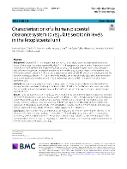| dc.contributor.author | Štaud, František | |
| dc.contributor.author | Pan, Xin | |
| dc.contributor.author | Karahoda, Rona | |
| dc.contributor.author | Dong, Xiaojing | |
| dc.contributor.author | Kastner, Petr | |
| dc.contributor.author | Horáčková, Hana | |
| dc.contributor.author | Váchalová, Veronika | |
| dc.contributor.author | Markert, Udo R. | |
| dc.contributor.author | Abad, Cilia | |
| dc.date.accessioned | 2023-10-30T10:10:34Z | |
| dc.date.available | 2023-10-30T10:10:34Z | |
| dc.date.issued | 2023 | |
| dc.identifier.uri | https://hdl.handle.net/20.500.14178/2056 | |
| dc.description.abstract | Background Serotonin (5-HT) is a biogenic monoamine with diverse functions in multiple human organs and tissues. During pregnancy, tightly regulated levels of 5-HT in the fetoplacental unit are critical for proper placental functions, fetal development, and programming. Despite being a non-neuronal organ, the placenta expresses a suite of homeostatic proteins, membrane transporters and metabolizing enzymes, to regulate monoamine levels. We hypothesized that placental 5-HT clearance is important for maintaining 5-HT levels in the fetoplacental unit. We therefore investigated placental 5-HT uptake from the umbilical circulation at physiological and supraphysiological levels as well as placental metabolism of 5-HT to 5-hydroxyindoleacetic acid (5-HIAA) and 5-HIAA efflux from trophoblast cells. Methods We employed a systematic approach using advanced organ-, tissue-, and cellular-level models of the human placenta to investigate the transport and metabolism of 5-HT in the fetoplacental unit. Human placentas from uncomplicated term pregnancies were used for perfusion studies, culturing explants, and isolating primary trophoblast cells. Results Using the dually perfused placenta, we observed a high and concentration-dependent placental extraction of 5-HT from the fetal circulation. Subsequently, within the placenta, 5-HT was metabolized to 5-hydroxyindoleacetic acid (5-HIAA), which was then unidirectionally excreted to the maternal circulation. In the explant cultures and primary trophoblast cells, we show concentration- and inhibitor-dependent 5-HT uptake and metabolism and subsequent 5-HIAA release into the media. Droplet digital PCR revealed that the dominant gene in all models was MAO-A, supporting the crucial role of 5-HT metabolism in placental 5-HT clearance. Conclusions Taken together, we present transcriptional and functional evidence that the human placenta has an efficient 5-HT clearance system involving (1) removal of 5-HT from the fetal circulation by OCT3, (2) metabolism to 5-HIAA by MAO-A, and (3) selective 5-HIAA excretion to the maternal circulation via the MRP2 transporter. This synchronized mechanism is critical for regulating 5-HT in the fetoplacental unit; however, it can be compromised by external insults such as antidepressant drugs. | en |
| dc.language.iso | en | |
| dc.relation.url | http://biomedcentral.com/articles/10.1186/s12958-023-01128-z | |
| dc.rights | Creative Commons Uveďte původ 4.0 International | cs |
| dc.rights | Creative Commons Attribution 4.0 International | en |
| dc.title | Characterization of a human placental clearance system to regulate serotonin levels in the fetoplacental unit | en |
| dcterms.accessRights | openAccess | |
| dcterms.license | https://creativecommons.org/licenses/by/4.0/legalcode | |
| dc.date.updated | 2023-12-14T17:40:32Z | |
| dc.subject.keyword | Placenta | en |
| dc.subject.keyword | Serotonin | en |
| dc.subject.keyword | Fetal development | en |
| dc.subject.keyword | Homeostasis | en |
| dc.subject.keyword | Clearance | en |
| dc.relation.fundingReference | info:eu-repo/grantAgreement/GA0/GA/GA20-13017S | |
| dc.relation.fundingReference | info:eu-repo/grantAgreement/UK/COOP/COOP | |
| dc.relation.fundingReference | info:eu-repo/grantAgreement/MSM//LX22NPO5107 | |
| dc.date.embargoStartDate | 2023-12-14 | |
| dc.type.obd | 73 | |
| dc.type.version | info:eu-repo/semantics/publishedVersion | |
| dc.identifier.doi | 10.1186/s12958-023-01128-z | |
| dc.identifier.utWos | 001053700500002 | |
| dc.identifier.eidScopus | 2-s2.0-85168591208 | |
| dc.identifier.obd | 637787 | |
| dc.identifier.pubmed | 37612712 | |
| dc.subject.rivPrimary | 30000::30100::30104 | |
| dcterms.isPartOf.name | Reproductive Biology and Endocrinology | |
| dcterms.isPartOf.issn | 1477-7827 | |
| dcterms.isPartOf.journalYear | 2023 | |
| dcterms.isPartOf.journalVolume | 21 | |
| dcterms.isPartOf.journalIssue | 1 | |
| uk.faculty.primaryId | 113 | |
| uk.faculty.primaryName | Farmaceutická fakulta v Hradci Králové | cs |
| uk.faculty.primaryName | Faculty of Pharmacy in Hradec Kralove | en |
| uk.department.primaryId | 371 | |
| uk.department.primaryName | Katedra farmakologie a toxikologie | cs |
| uk.department.primaryName | Deparment of Pharmacology and Toxicology | en |
| uk.department.secondaryId | 373 | |
| uk.department.secondaryName | Katedra farmaceutické chemie a farmaceutické analýzy | cs |
| uk.department.secondaryName | Department of Pharmaceutical Chemistry and Pharmaceutical Analysis | en |
| dc.description.pageRange | nestránkováno | |
| dc.type.obdHierarchyCs | ČLÁNEK V ČASOPISU::článek v časopisu::původní článek | cs |
| dc.type.obdHierarchyEn | JOURNAL ARTICLE::journal article::original article | en |
| dc.type.obdHierarchyCode | 73::152::206 | en |
| uk.displayTitle | Characterization of a human placental clearance system to regulate serotonin levels in the fetoplacental unit | en |

